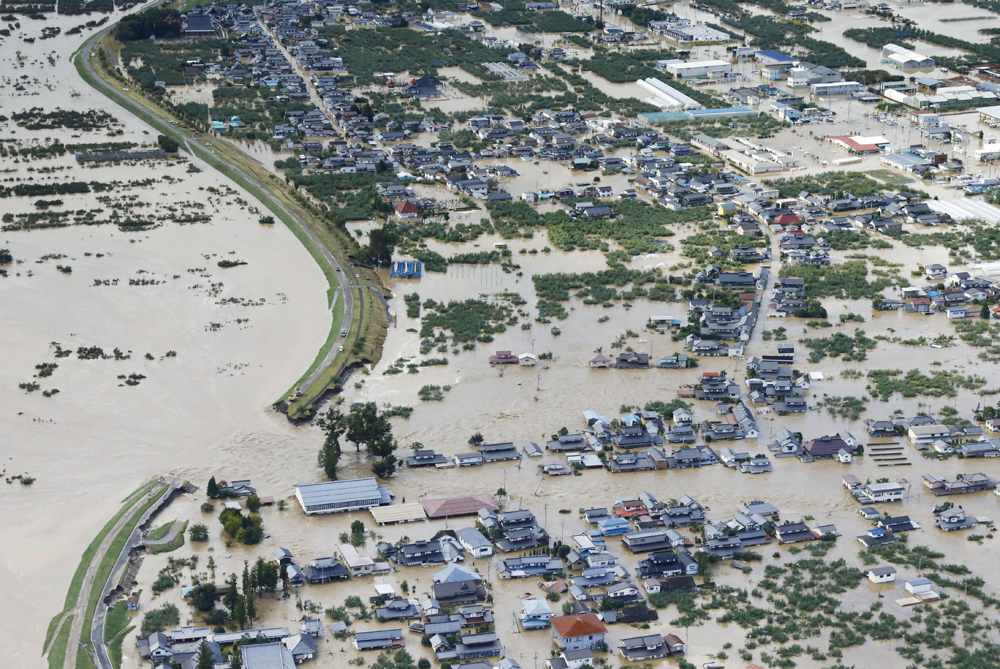Typhoon Hagibis has caused severe flooding, as well as some damage from its winds, across a wide swathe of Japan after the storm made landfall yesterday evening local time in Shizuoka prefecture and passed across the Tokyo metro area.
Before typhoon Hagibis even arrived rainfall totals were nearing record levels, with Hakkone recording over two feet of rain in a 12 hour period. Now, rainfall totals from the large storm’s approach and passage across some areas have resulted in more than one metre of rain in 48 hours, approaching record levels of deluge. Maximum wind gusts recorded appear to have been around the 100 mph to perhaps as high as 120 mph, while sustained winds of hurricane strength were seen.
Coming on the heels of typhoon Faxai, which damaged around 30,000 properties, the job of now allocating claims to the different storms will become increasingly challenging for the insurance and reinsurance sector, as was warned by the CEO of reinsurance company RenRe last week.
As daylight came to Japan on Sunday morning, the scale of the flooding and damage has become clear, with some towns seeing failures of flood defences and river flooding impacting residential areas.
Among the worst hit is Nagano prefecture, north of the landfall area, where the Chikuma River burst its banks and has resulted in severe flooding across both residential and industrial areas.
In Tokyo and surrounding prefectures flooding from rivers including the Tama has been seen, but in the main the cities robust flood defences seem to have done their job and held back the waters from causing even more significant damage.
19 people are reported to have lost their lives across Japan due to the impacts of typhoon Hagibis, with more than 100 injured, with rescue operations underway across the country to help more.
Typhoon Hagibis caused a roughly 70 meter stretch of river defence for the Chikuma river to collapse flooding parts of Nagano City, where floodwaters have been seen to be more than 2 meters high across a wide area.

Image from Kyodo agency (via Japan Today)
Bullet trains were flooded in their rail yard in Nagano, raising the prospect of a sizeable insurance claim should they prove damaged.
Scenes in some areas of Tokyo also show rivers that burst their banks, although to a much lesser degree, however the rain related flooding has also caused widespread damage even where river defences held and there is expected to be a significant number of properties requiring repair as a result.
Saitama, Kawasaki and other major urban and residential areas have seen floodwaters rushing through homes and businesses, which will add to the claims coming in for insurers.
In total around 50 landslides and mudflows were reported across a wide swathe of Japan, with damage to property covering a very wide area with this typhoon as a result.
That will make the process of assessing and quantifying the damage very challenging for insurance and reinsurance interests, given the wide area impacted, the damage that had already been seen from rainfall induced flooding in the days prior to typhoon Hagibis in some central areas and the fact repairs from typhoon Faxai, which hit a similar albeit smaller area, are ongoing as well.
Damage extends further north as well, as typhoon Hagibis travelled up the coast and impacted Fukushima prefecture as well, where the Abukuma River topped its banks in the city of Koriyama, flooding properties.
On Saturday, as the outer rain bands of typhoon Hagibis lashed Tokyo, a tornado formed in Ichihara, Chiba Prefecture and destroyed 12 properties, with more than 70 damaged.
Tokyo Electric Power Company said more than 95,000 homes were left without power in Chiba, the prefecture already badly affected by Faxia, with another 75,000 without power in surrounding prefectures and there were another 18,000 that lost power further north in Tohoku.
The challenge associated with understanding the financial impacts of typhoon Hagibis will now begin, with insurance, reinsurance and ILS market interests all looking at their portfolios and exposures, counterparty contracts and trying to identify where losses may fall.
Risk modellers are likely to produce impact assessments and estimates for the insurance and reinsurance industry loss, but with Faxai so recent this could be more challenging than normal, as was seen after Jebi last year as it came so close to another typhoon.
While there will be a significant number of residential properties damaged by this typhoon, as well as industrial and commercial assets, the insured component will be harder to determine given the majority of damage appears to be by water, rather than wind.
We’ll update you as more information becomes available and early pronouncements of industry loss emerge.
 View all of our Artemis Live video interviews and subscribe to our podcast.
View all of our Artemis Live video interviews and subscribe to our podcast.
All of our Artemis Live insurance-linked securities (ILS), catastrophe bonds and reinsurance video content and video interviews can be accessed online.
Our Artemis Live podcast can be subscribed to using the typical podcast services providers, including Apple, Google, Spotify and more.































